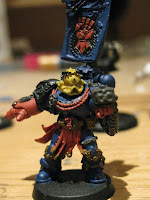The force:-
HQ
Shas'el with missile pod (twin linked), shield drone and iridium armour. 103pts
Troops
8 man Firewarrior team with team leader. 90pts (5 of these squads)
Fast attack
5 man pathfinder team with team leader. 70pts
Pathfinder devilfish with disruption pod. 85pts
5 man pathfinder team with team leader. 70pts
Pathfinder devilfish with disruption pod. 85pts
Piranha skimmer with fusion blaster. 65pts
Heavy support
Monat Broadside suit (teamleader) with advanced stabilisation system and shield drone. 100 pts
Monat Broadside suit (teamleader) with advanced stabilisation system and shield drone. 100 pts
Elite
2 man crisis suit team with plasmarifle and missile pod (plus multi tracker). 124pts
2 man crisis suit team with plasmarifle and missile pod (plus multi tracker). 124pts
2 man crisis suit team with plasmarifle and missile pod (plus multi tracker). 124pts
Mix of a static firebase with a pair of devilfish taxi's to ferry firewarrior teams onto objectives. Plenty of marker lights to help in the shooting phase and crisis suits to add weight where they're needed against heavily armoured elites or taking town transports (twin linked missile pods make a mess of armour 11). Greatest weakness is against (you've guessed it) jump infantry and dark eldar forces with all those easy pain tokens available but at least the 6 crisis suits will deny feel no pain on all their shots and have plenty of firepower effective upto AV 11 (12 at a push). Had in mind a strike force that works with very rapid forward elements (the crisis suits and piranha) clearing safe zones for the slower firebase to establish in and lay down fields of fire.
With that in mind I looked through my old Tau bits box and found the components to build a crisis suit (I collected them for a LONG time). The list still isn't complete though and many things may need changing so the suit needed to be flexible, a great opportunity to practice using hobby magnets. Available most places but I got mine here they are great at positioning and posing models without the need to glue in place.
The sections needed a small amount of drilling to ensure the magnet sat inside the arm or weapon to avoid it sticking out conspicuously but this was easily done and the magnet secured with a small amount of epoxy resin at the correct angle. With approximately 12 magnets almost every standard weapon combination is possible. I placed magnets in either arm and both shoulders. A tip is to ensure the facing of the magnets is the same for all positions (ie. the weapons all have S pole facing out whilst all 'anchor points' have the N pole facing out, this gives maximum versatility.
 Now I can construct my army and model without fear of it becoming obsolete as new codex's are released or my own desire for the role of this model shifts or just mess around with loadouts.
Now I can construct my army and model without fear of it becoming obsolete as new codex's are released or my own desire for the role of this model shifts or just mess around with loadouts.Looks like I'm collecting Tau again, Its going to be a long few months till Throne of Skulls.




















